This module examines the dangers of concrete corrosion, exploring the most common causes and offering guidance on the most effective methods of repair. It is sponsored by Mapei
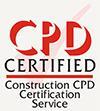
How to take this module
UBM’s CPD distance-learning programme is open to anyone seeking to develop their knowledge and skills. Each module also offers members of professional institutions an opportunity to earn between 30 and 90 minutes of credits towards their annual CPD requirement.
This article is accredited by the CPD Certification Service. To earn CPD credits, read the article and then click the link below to complete your details and answer the questions. You will receive your results instantly, and if all the questions are correctly answered, you will be able to download your CPD certificate straight away.
CPD CREDITS: 60 MINUTES
DEADLINE: 18 DECEMBER 2015
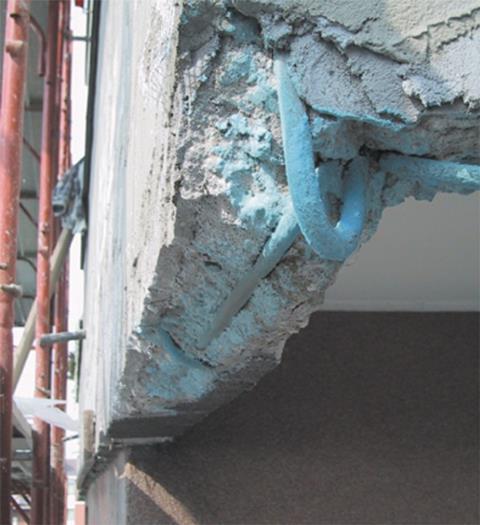

INTRODUCTION TO BS EN 1504
Damage to concrete structures can arise from a wide range of factors, including overloading, fire damage, blast damage and natural events such as earthquakes. But it is often the result of poor specification, design or construction, leading to the corrosion of embedded steel or chemical damage. Common symptoms include the growth of black-coloured rust, cracking and spalling.
There is also a commonly held but false belief that the problem can be solved if the deteriorated material is removed and replaced with any type of repair mortar.
The British and European standard BS EN 1504 “Products and systems for the repair and protection of concrete structures – definitions, requirements, quality control and evaluation of conformity” defines appropriate procedures and characteristics of products used to repair, maintain and protect concrete structures. The main aim of the standard is to provide a valid instrument to correctly identify problems and optimise repair operations.
Within BS EN 1504 there are various sections covering elements of concrete repair, such as quality control, testing and materials. The key parts are:
- BS EN 1504-8, which sets out testing and compliance definitions for manufacturers
- BS EN 1504-9, which sets out specification guidelines
- BS EN 1504-10, which sets out material application guidelines for contractors.
One of the most important steps in any concrete repair is to diagnose why the structure has been damaged, in order to ensure that once the building has been repaired it will remain in a sound condition for the rest of its life. This CPD outlines how to identify concrete corrosion and diagnose the root causes, as well as explaining how BS EN 1504 can help specifiers to adopt appropriate repair principles and methods.
It is important to take part 9 into consideration before any other part of the standard. This defines principles and methods for protecting and repairing concrete structures that have suffered, or may suffer, damage or deterioration, and offers a guide to choosing products and systems suitable for their intended use.

CORROSION OF REINFORCEMENT
When reinforcing steel is embedded in concrete, it is protected by an iron oxide film, created during the hydration process in the highly alkaline environment of the concrete (the pH value of good-quality concrete is between 12.5 and 13.5). The oxide film, known as a “passivating layer”, insulates the steel against oxygen and humidity, causing it to become immune to corrosion.
However, there are two factors that can disrupt the protective layer: these are carbonation and atmospheric gases such as carbon dioxide (CO2) and sulphur dioxide.
Carbonation
Carbonation in concrete is the formation of calcium carbonate caused by a chemical reaction between three elements:
- CO2, found in the air
- Calcium (Ca), found in the concrete
- Water (H2 O), also found in the concrete
Damage caused by the carbonation of concrete is a three-stage process.
- In the initiation stage, CO2 enters the concrete and the pH begins to drop to become more acidic. The steel is not yet affected.
- In the propagation stage, the CO2 reacts with the water to produce carbonic acid (H2 CO3). This in turn begins to react with the calcium within the concrete, producing calcium carbonate (CaCO3). When the pH level drops below 11, the passivating film is neutralised, and the rods are left exposed to attack from the oxygen and humidity present in the atmosphere. As the corrosion process accelerates, the surface of the concrete starts to discolour – this may vary from a light grey (which can be difficult to detect) to strong orange.
- Under these conditions, the deterioration stage begins. Corrosion of the reinforcement rods increases their volume by approximately six times. The surrounding concrete detaches from the rods, and may even be completely pushed out. Once the concrete has started to crack, deterioration of the reinforcement rods will progress more quickly because oxygen and humidity can enter the structure more easily.
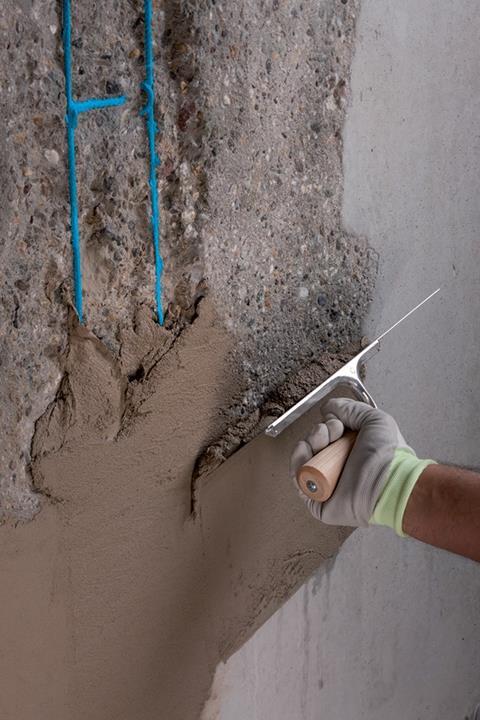
Chloride attacks
Concrete can also be attacked by the chloride ions found in de-icing salts, marine environments, or contaminated raw materials. This causes a black-coloured rust to form and, as with carbonation, can severely damage the surface of the concrete.
Once the chloride penetrates the concrete and reaches the reinforcement rods, it breaks down the passivating layer so that the steel is exposed and begins to corrode. Penetration time depends on a number of factors, such as:
- The concentration of chlorides coming into contact with the surface of the concrete
- Permeability of the concrete
- Percentage of humidity present.
Corrosion requires the presence of both chlorides and oxygen. For example, a structure completely immersed in seawater will have a high chloride content, but because the concrete is completely saturated, oxygen will not be able to penetrate. Corrosion of the reinforcement rods will therefore be negligible.
The concentration of chlorides required to promote corrosion is directly proportional to the pH of the concrete: the higher the alkalinity, the higher the concentration of chlorides that will be required to start the process. Thus, carbonation increases susceptibility to chloride attacks: as carbonation lowers the pH of the concrete, even those areas of the structure with a lower concentration of chlorides will become more vulnerable.
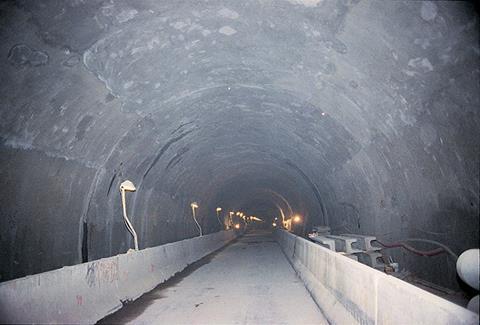
CONTRIBUTORY FACTORS
Evaluating the underlying contributors to deterioration is essential. These can arise at any point in a project, from design and construction to maintenance.
- Design During the design of the structure you must determine what sort of wear is likely to occur and whether salts will be present in the area. It is also crucial to design the reinforcement structure to accommodate movement in order to maintain the correct level of concrete cover.
- Material specification When selecting materials it is important to remember that precast concrete panels are especially prone to chlorides because salts are used to accelerate the manufacturing process. Marine aggregates can also introduce salt into the concrete mix.
- Construction The more porous the concrete, the easier it is for both carbonation and chloride attacks to occur. A high water content, which can make concrete easier to work, can also leave it weak and liable to let in more water and contaminants. Increased porosity can also be caused by poor compaction, which creates blowholes or honeycombing, and lack of curing, which leaves concrete susceptible to surface crazing. The correct installation of reinforcement is also essential – poorly set spacers can result in an incorrect level of concrete cover, while on more complex pours, cages have been known to slip.
- Maintenance This is often non-existent or at very low levels due to the perception that concrete is indestructible. It is normally only when defects are identified that work is undertaken. It is important that post-repair inspections are carried out regularly. This includes repairing damage caused by external factors that could cause distress to the protective coating system and any areas where concrete has been removed due to impact.
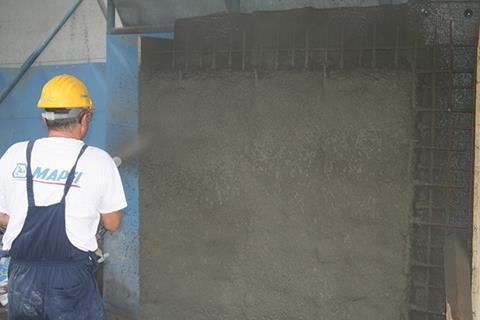
GUIDANCE ON REPAIRS
Once the cause and severity of the defects is understood, there is a range of options for remediation, from patch repairs to full replacement. BS EN 1504-9 lists 10 “principles” for the repair and protection of concrete structures. These are:
1. Protection against ingress
2. Moisture control
3. Concrete restoration
4-5. Structural strengthening
6. Resistance to chemicals
7. Preservation or restoring passivity
8. Increasing resistivity
9. Cathodic control
10. Cathodic protection.
These principles and the related repair methods are detailed in the remaining parts of the standard, 2-7. BS EN 1504-3, for example, considers products and systems for structural and non-structural repair, and therefore provides guidance on addressing principles 3, 4 and 7. Below, we show the requirements set out in part 3 for structural and non-structural repair mortars.
The standard defines four mortar classes: R1 and R2 for non-structural mortar and R3 and R4 for structural mortar.
Table 1: Requirements for structural and non-structural repair mortars
| Performance characteristics | Test method | Requirement | |||
|---|---|---|---|---|---|
| Non-structural | Structural | ||||
| Class R1 | Class R2 | Class R3 | Class R4 | ||
| Compressive strength | BS EN 12190 | ≥ 10MPa | ≥ 15MPa | ≥ 25MPa | ≥ 45MPa |
| Chloride ion content | BS EN 1015-17 | ≤ 0.05% | ≤ 0.05% | ≤ 0.05% | ≤ 0.05% |
| Adherence bond | BS EN 1542 | ≥ 0.8MPa | ≥ 0.8MPa | ≥ 1.5MPa | ≥ 2.0MPa |
| Contrasted expansion/shrinkage | BS EN 12617-4 | No requirement | Bond strength after test ≥ 0.8MPa | Bond strength after test ≥ 1.5MPa | Bond strength after test ≥ 2.0MPa |
| Durability – resistance to carbonation | BS EN 13295 | No requirement | dk ≥ control concrete (concrete of reference type MC 0,45) | ||
| Modulus of elasticity | BS EN 13412 | No requirement | No requirement | ≥ 15GPa | ≥ 20GPa |
| Thermal compatibility: Freezing-thawing | BS EN 13687-1 | Visual inspection after 50 cycles | Bond strength after 50 cycles ≥ 0.8MPa | Bond strength after 50 cycles ≥ 1.5MPa | Bond strength after 50 cycles ≥ 2.0MPa |
| Thermal compatibility: Storms | BS EN 13687-2 | Visual inspection after 30 cycles | Bond strength after 30 cycles ≥ 0.8MPa | Bond strength after 30 cycles ≥ 1.5MPa | Bond strength after 30 cycles ≥ 2.0MPa |
| Thermal compatibility Dry cycles | BS EN 13687-4 | Visual inspection after 30 cycles | Bond strength after 30 cycles ≥ 0.8MPa | Bond strength after 30 cycles ≥ 1.5MPa | Bond strength after 30 cycles ≥ 2.0MPa |
| Slip resistance | BS EN 13036-4 | Class I: > 40 units with damp test | |||
| Class II: > 40 units with dry test | |||||
| Class III: > 55 units with damp test | |||||
| Thermal expansion coefficient | BS EN 1770 | Not required if tests 7, 8 or 9 are carried out, otherwise declared value | |||
| Capillary absorption (permeability to water) | BS EN 13057 | No requirement | ≤ 0.5kg∙m-2∙h-0.5 | ||
Privacy policy
Information you supply to UBM Information Ltd may be used for publication and also to provide you with information about our products or services in the form of direct marketing by email, telephone, fax or post. Information may also be made available to third parties. UBM Information Ltd may send updates about ��ɫ����TV CPD and other relevant UBM products and services. By providing your email address you consent to being contacted by email by UBM Information Ltd or other third parties. If at any time you no longer wish to receive anything from UBM Information Ltd or to have your data made available to third parties, contact the Data Protection Coordinator, UBM Information Ltd, FREEPOST LON 15637, Tonbridge, TN9 1BR, Freephone 0800 279 0357 or email ubmidpa@ubm.com. View our full privacy policy at






















No comments yet